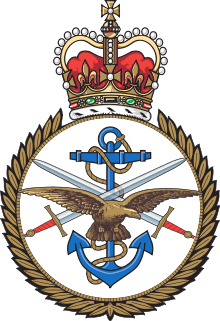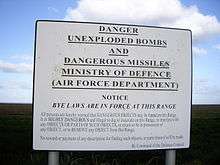Defence Council of the United Kingdom
The Defence Council of the United Kingdom is the body legally entrusted with the defence of the United Kingdom and its overseas territories and with control over the British armed forces, and is part of the Ministry of Defence.[2]
 | |
| Agency overview | |
|---|---|
| Formed | 1964 |
| Preceding |
|
| Jurisdiction | |
| Headquarters | Whitehall, Westminster, London |
| Agency executive | |
| Parent agency | Ministry of Defence |

Functions
Prior to 1964, there were five bodies responsible for the British Armed Forces: the Admiralty, the War Office, the Air Ministry, the Ministry of Aviation, and a smaller Ministry of Defence. By Orders-in-Council issued under the Defence (Transfer of Functions) Act 1964,[3] the functions of these bodies were transferred to the Defence Council and the Secretary of State for Defence, who heads a larger Ministry of Defence.
The Secretary of State for Defence, who is a member of the Cabinet, chairs the Defence Council, and is accountable to the Queen and to Parliament for its business. The letters patent constituting the Defence Council vest it with the power of command over Her Majesty's Forces and give it responsibility for their administration, or in the words of the letters patent:
…to administer such matters pertaining to Our Naval Military and Air Forces as We through Our Principal Secretary of State for Defence direct them to execute And to have command under Us of all Officers Ratings Soldiers and Airmen of Our Naval Military and Air Forces…
In practice, the Defence Council is a formal body, and almost all its work is conducted by the Defence Board. In addition, the three service boards (the Admiralty Board, the Army Board and the Air Force Board), which are sub-committees of the Defence Council meet annually for each service chief to report to the Secretary of State on the health of their respective services.[4]
Membership
As of June 2020, membership of the Defence Council is as follows:[5]
| Members | Title | Name |
|---|---|---|
| Political | Secretary of State for Defence (Chairperson) | The Rt Hon Ben Wallace |
| Minister of State for the Armed Forces | James Heappey | |
| Minister of State and the Lords Spokesman on Defence | Baroness Goldie | |
| Her Majesty's Civil Service | Permanent Secretary | Sir Stephen Lovegrove |
| Director General Finance | Charlie Pate | |
| Military | Chief of the Defence Staff | General Sir Nicholas Carter |
| Vice-Chief of the Defence Staff | Admiral Timothy Fraser | |
| First Sea Lord and Chief of Naval Staff | Admiral Tony Radakin | |
| Chief of the General Staff | General Sir Mark Carleton-Smith | |
| Chief of the Air Staff | Air Chief Marshal Mike Wigston | |
| Commander Strategic Command | General Sir Patrick Sanders | |
Defence Board
The Defence Board is described as the highest committee of the Ministry of Defence, responsible for the full range of defence business other than the conduct of operations.[6] It meets every month and provides strategic direction and oversight of defence matters.[7]
| Members | Title | Name |
|---|---|---|
| Political | Secretary of State for Defence (Chairperson) | The Rt Hon Ben Wallace |
| Minister of State | Baroness Goldie | |
| Her Majesty's Civil Service | Permanent Secretary | Sir Stephen Lovegrove |
| Director General Finance | Charlie Pate | |
| Military | Chief of the Defence Staff | General Sir Nicholas Carter |
| Vice-Chief of the Defence Staff | Admiral Timothy Fraser | |
| Non-executive board members | Lead Non-Executive Board Member | Sir Gerry Grimstone |
| Chair of the Defence Audit Committee | Simon Henry | |
| Chair of the Defence Equipment and Support Board | Paul Skinner | |
| Chair of the People Committee | Danuta Grey | |
References
- "Ben Wallace Named New Defence Secretary". Forces Network. 25 July 2019. Retrieved 23 September 2019.
- "Defence Council". Ministry of Defence. Retrieved 11 February 2011.
- "No. 43277". The London Gazette. 20 March 1964. p. 2545.
- "How Defence Works (December 2015)" (PDF). Ministry of Defence. Retrieved 16 June 2016.
- MOD website
- "Our Governance". Ministry of Defence. Retrieved 16 June 2016.
- "How Defence Works (December 2015)" (PDF). Ministry of Defence. Retrieved 16 June 2016.